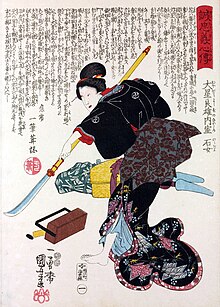Naginatadō
Naginatadō ( 薙刀 道 ) or Naginatajutsu ( Japanese 薙刀 術 ) is the art of fighting with the Japanese Naginata . This is a type of glaive that looks something like a short sword blade ( wakizashi ) on a long pole. The total length of the weapon is about 7 shaku , or about 2.12 m.
Naginatajutsu refers to the technical aspect of fighting the Naginata - Naginatadō also includes the mental and spiritual aspects.
history
Naginatajutsu is still widely practiced today, especially in Japan; this weapon art is especially popular there with women. In Europe, this often leads to the misjudgment that Naginatajutsu is a purely women's sport, which, however, does not correspond to the facts. It is one of the oldest Japanese martial arts and goes back to the origins of the warrior class. So it is a martial art that is at least as old as sword fighting and archery , possibly even older than the latter. The Japanese authorities date the oldest regular schools of Naginata technique back to 1168, while the oldest school of sword fighting is believed to have been founded around 1350.
At that time there were different varieties of Naginata, such as weapons with a cross-shaped blade, which looks very similar to the European halberds. These weapons were very popular with warriors, especially among the rebellious monastic armies in the 11th and 12th centuries and later with the Bushi , the warrior class from the 12th to the 15th centuries.
Over time, the yari , a light spear with a straight blade, began to be preferred as a weapon against the sword. He proved to be more effective both on foot and on horseback and also in formation combat. During the Ōnin war (1467–1477), the yari was introduced at the expense of the Naginata, and the latter was banished to the household of the Bushi women ( Onna-bugeisha ) and certain sects. Today Naginatajutsu is mainly taught in girls' schools and has been gaining popularity in the USA and, to a lesser extent, in Europe .
As with kendō , different schools developed in Naginatajutsu. The number of schools that have taught Naginatajutsu throughout history is estimated to be around 425, although it should be noted that not a few of these schools also taught other fighting styles. The techniques of these schools were mostly more drastic than those of today, and were mainly practiced by women. There are also men nowadays who practice this art, often reaching a high degree.
Naginatajutsu required a great deal of stamina in order to properly handle the weapon, i.e. to make full use of the blade and the handle.
The current practice of this sport under the supervision of the Japan-wide Naginata Association is called Atarashii Naginata , which literally means "new Naginata [style]". The training fights are mostly fought Naginata against Naginata. A relatively light naginata made of wood, preferably oak, with a bamboo blade, which is comparable to the Shinai from Kendo, is used for training fights . This training weapon is about 2.10 m to 2.25 m long. The protective clothing ( Bogu ) is similar to that in the Kendō, but shin guards ( Sune ate ) are also worn.
Germany
In Germany there are now 6 dōjōs that offer lessons in Atarashi-Naginata. These are the Kenshinkai Berlin e. V. (formerly SC Kamakura, in Berlin), the Post Sports Club Opladen , the Police Sports Club Mainz , the Naginata Group in general university sports at the Johannes Gutenberg University Mainz , the Shichi Fukujin Dōjō Potsdam (from Genkido - Asia in Germany) and the Gymnastics Club 1863 eV Worms-Leiselheim in Worms. The oldest existing Naginata group in Germany can be found in Kenshinkai Berlin e. V. The youngest Naginata group in Germany is in the Turnverein 1863 eV Worms-Leiselheim.
The German Naginata Bund, DNagB for short, has existed since 2003, under whose administration the German Championship is held every year. The DNagB is a member of the European Naginata Federation, the highest European institution in Naginata.
Web links
- Naginata Home Page (English)
Individual evidence
- ↑ admin: Naginata - Lance fencing from the time of the samurai. May 24, 2010, accessed November 6, 2018 .
- ↑ PostsportvereinOpladen1967e.V. - Naginata. Retrieved November 6, 2018 .
- ↑ Various authors: Naginata - Japanese lance fencing - PSV Mainz, your Mainz sports club. December 21, 2005, accessed November 6, 2018 .
- ↑ Johannes Gutenberg University Mainz: Naginata team of general university sports at Johannes Gutenberg University Mainz is the German runner-up. Retrieved November 6, 2018 .
- ^ Naginata Germany. Accessed November 6, 2018 (German).
- ^ TV 1863 eV Worms-Leiselheim - Naginata. Retrieved November 6, 2018 .
- ↑ Home - Deutscher Naginata Bund eV Retrieved on November 6, 2018 (German).
- ↑ Home . In: European Naginata Federation . ( naginata-federation.eu [accessed November 6, 2018]).


